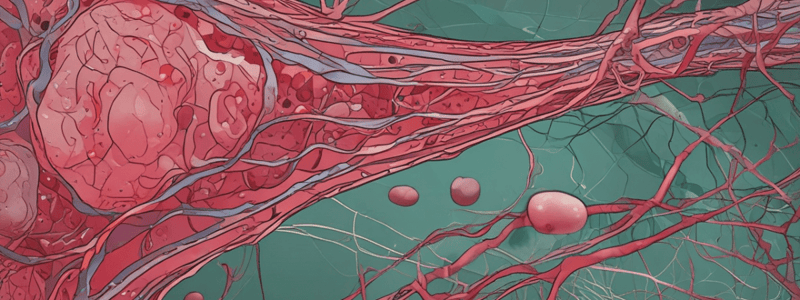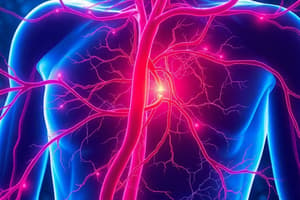Podcast
Questions and Answers
What happens when there is a hole in a blood vessel?
What happens when there is a hole in a blood vessel?
- The blood vessel stretches to close the hole
- The platelets stick together to clog up the hole (correct)
- The blood vessel breaks down
- The platelets move away from the hole
Why don't platelets clump together in other areas of the blood vessel?
Why don't platelets clump together in other areas of the blood vessel?
- Because collagen is only present at the site of injury
- Because the environment in the blood vessel is the same everywhere
- Because platelets are only activated by collagen at the site of injury (correct)
- Because the blood vessel is too narrow in other areas
What is the purpose of the platelet plug?
What is the purpose of the platelet plug?
- To increase blood flow to the affected area
- To repair the hole in the blood vessel
- To stimulate the immune response
- To prevent blood loss from the hole in the blood vessel (correct)
What is the name of the protein that forms a mesh to strengthen the platelet plug?
What is the name of the protein that forms a mesh to strengthen the platelet plug?
What do fibrin subunits do?
What do fibrin subunits do?
Where is collagen typically found?
Where is collagen typically found?
What is the name of the second step in the clotting mechanism?
What is the name of the second step in the clotting mechanism?
What would happen if fibrin molecules were circulating in the blood?
What would happen if fibrin molecules were circulating in the blood?
What is the precursor to fibrin?
What is the precursor to fibrin?
Why is collagen necessary for platelet plug formation?
Why is collagen necessary for platelet plug formation?
What is the primary function of endothelial cells in a blood vessel?
What is the primary function of endothelial cells in a blood vessel?
What would happen if a blood vessel gets damaged and is not fixed?
What would happen if a blood vessel gets damaged and is not fixed?
What is the role of platelets in the body?
What is the role of platelets in the body?
What is unique about platelets?
What is unique about platelets?
What is the function of the nucleus in endothelial cells?
What is the function of the nucleus in endothelial cells?
What is the characteristic of endothelial cells that prevents blood from coming out?
What is the characteristic of endothelial cells that prevents blood from coming out?
What is the shape of endothelial cells when viewed in cross-section?
What is the shape of endothelial cells when viewed in cross-section?
What is the purpose of endothelial cells forming a tube in a blood vessel?
What is the purpose of endothelial cells forming a tube in a blood vessel?
What is the main difference between a fibrinogen and a fibrin molecule?
What is the main difference between a fibrinogen and a fibrin molecule?
Where do fibrinogen molecules need to be converted to fibrin molecules?
Where do fibrinogen molecules need to be converted to fibrin molecules?
What is the role of tissue factor in the blood clotting process?
What is the role of tissue factor in the blood clotting process?
Why is it more efficient for tissue factor to activate other proteins to convert fibrinogen to fibrin?
Why is it more efficient for tissue factor to activate other proteins to convert fibrinogen to fibrin?
What is the purpose of the added piece on a fibrinogen molecule?
What is the purpose of the added piece on a fibrinogen molecule?
Where are tissue factor proteins typically found in the body?
Where are tissue factor proteins typically found in the body?
What is the result of the activation of multiple proteins by tissue factor?
What is the result of the activation of multiple proteins by tissue factor?
What is the relationship between fibrin and platelets in the blood clotting process?
What is the relationship between fibrin and platelets in the blood clotting process?
Why does the body use a cascade of proteins to convert fibrinogen to fibrin?
Why does the body use a cascade of proteins to convert fibrinogen to fibrin?
What is the main function of the added piece on a fibrinogen molecule?
What is the main function of the added piece on a fibrinogen molecule?
Flashcards are hidden until you start studying
Study Notes
Blood Vessel Structure
- A blood vessel is a tube through which blood travels
- The walls of the blood vessel are made up of endothelial cells that are stuck together tightly to prevent blood from coming out
Platelets and Blood Clotting
- Platelets are tiny pieces of cells that help to block up holes in blood vessels
- When a blood vessel is damaged, platelets come together to form a platelet plug, which blocks the hole and prevents blood loss
- The platelet plug is formed through chemical interaction with collagen, a structural protein found outside of blood vessels
Fibrin and Blood Clot Strengthening
- Fibrin is a protein that strengthens the platelet plug by forming a mesh of protein that holds the platelets together
- Fibrin is formed from fibrinogen, a protein that circulates in the blood
- Fibrinogen is converted to fibrin through a series of chemical reactions triggered by tissue factor, a protein found outside of blood vessels
Coagulation Cascade
- The conversion of fibrinogen to fibrin is a complex process involving multiple proteins and enzymes
- Tissue factor is the initial trigger that sets off a cascade of chemical reactions, leading to the activation of thrombin, an enzyme that breaks down fibrinogen to form fibrin
- The coagulation cascade is a process that amplifies the signal, allowing a small amount of tissue factor to trigger the formation of a large amount of fibrin.
Studying That Suits You
Use AI to generate personalized quizzes and flashcards to suit your learning preferences.




